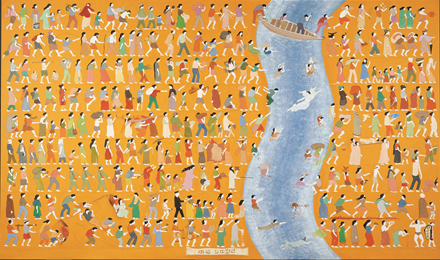2Repetition of Motifs to Reflect Both the World’s Universality and Diversity
A striking feature of N. S. Harsha’s paintings is the repeated rendering of animal and/or human motifs in a single work. From a distance, the tidy arrangements of similar-looking individuals appear to form a cohesive group, but on closer inspection, they differ in myriad ways: facial expressions, gestures, clothing... the characteristics of each becoming apparent. His paintings thus seem to reflect the diverse nature of India – a single nation, yet composed of multiple languages, faiths and cultures – and at the same time, reveal in miniature a world that could be any country, anywhere.
With their contrasting viewpoints of whole and part, group and individual, the paintings of N. S. Harsha reflect the artist’s position as an objective observer of the world.
Work That Defined His Painting Style
The triptych We Come, We Eat, and We Sleep (1999-2001) established his style of portraying row upon row of people. The many stages of life from birth to death are depicted through the very basic and everyday acts of moving, eating, and sleeping.

We Come, We Eat, and We Sleep (detail)
1999 - 2001
Synthetic polymer paint on canvas
172.1 x 289.3cm, 169.7 x 288.5cm, 172.2 x 289.2cm
Collection: Queensland Art Gallery, Brisbane